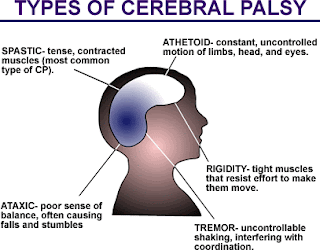Nursing Care Plan for Cerebral Palsy (CP)
NCP - Nursing Care Plan for Cerebral Palsy (CP)

Cerebral palsy (CP) is an umbrella term for a group of disorders affecting body movement, balance, and posture. Loosely translated, cerebral palsy means “brain paralysis.” Cerebral palsy is caused by abnormal development or damage in one or more parts of the brain that control muscle tone and motor activity (movement). The resulting impairments first appear early in life, usually in infancy or early childhood. Infants with cerebral palsy are usually slow to reach developmental milestones such as rolling over, sitting, crawling, and walking.
Treatment
Treatment for cerebral palsy is a lifelong multi-dimensional process focused on the maintenance of associated conditions. In order to be diagnosed with cerebral palsy the damage that occurred to the brain must be non-progressive and not disease like in nature. The manifestation of that damage will change as the brain and body develop, but the actual damage to the brain will not increase. Treatment in the life of cerebral palsy is the constant focus on preventing the damage in the brain from prohibiting healthy development on all levels. The brain, up to about the age of 8, is not concrete in its development. It has the ability to re-organize and re-route many signal paths that may have been affected by the initial trauma; the earlier it has help in doing this the more successful it will be. Various forms of therapy are available to people living with cerebral palsy as well as caregivers and parents caring for someone with this disability. They can all be useful at all stages of this disability and are vital in a person with cerebral palsy's ability to function and live more effectively. In general, the earlier treatment begins the better chance children have of overcoming developmental disabilities or learning new ways to accomplish the tasks that challenge them. The earliest proven intervention occurs during the infant's recovery in the neonatal intensive care unit (NICU). Treatment may include one or more of the following: physical therapy; occupational therapy; speech therapy; drugs to control seizures, alleviate pain, or relax muscle spasms (e.g. benzodiazepienes, baclofen and intrathecal phenol/baclofen); hyperbaric oxygen; the use of Botox to relax contracting muscles; surgery to correct anatomical abnormalities or release tight muscles; braces and other orthotic devices; rolling walkers; and communication aids such as computers with attached voice synthesizers. For instance, the use of a standing frame can help reduce spasticity and improve range of motion for people with CP who use wheelchairs. Nevertheless, there is only some benefit from therapy. Treatment is usually symptomatic and focuses on helping the person to develop as many motor skills as possible or to learn how to compensate for the lack of them. Non-speaking people with CP are often successful availing themselves of augmentative and alternative communication systems such as Blissymbols. Constraint-induced movement therapy (CIMT) has shown promising evidence in helping individuals with neurological disorders that have lost most of the use of an extremity. Research has proven the positive benefits of CIMT for people who have had a stroke and traumatic brain injury. However, later studies have addressed the application of CIMT for children with CP challenged with hemiparesis, that show a significant benefit in constraint induced movement therapy for children with cerebral palsy who are challenged with hemiparesis.wikipedia
Nursing Diagnosis Nursing Care Plan for Cerebral Palsy (CP)
- Risk for Injury related to disturbances in motor function
- Imbalanced Nutrition, Less Than Body Requirements related to difficulty swallowing and increased activity
- Activity Intolerance related to disorders of movement and posture that is not progressive
- Ineffective Tissue Perfusion related to cerebral edema that change / stop the blood flow of arterial / venous
- Risk for Infection related to suppression of inflammatory response (due to - drugs)
- Knowledge Deficit related to home care and therapeutic needs
Komentar
Posting Komentar